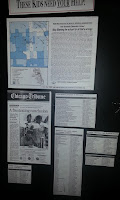We're nearing the end of this school year and are at the end of the annual April Volunteer Recognition Month. Volunteer-based tutor/mentor programs all over the country have been making an effort to recognize the people who have given time and talent over the past year, while are also (I hope) looking for ways to motivate many of those volunteers to return for another year when the 2024-25 school year begins in late August.
I've been digitizing newsletters and yearbooks from the two tutor/mentor programs I led between 1975 and 2011 and thought I'd do some volunteer recognition today.
Below is a page from the 1991-92 yearbook of the tutor/mentor program I led in Chicago from 1975 to the fall of 1992.
This program was started in 1965. I joined as a volunteer in 1973 and became a member of the leadership committee in 1974. In the summer of 1975 I was chosen to be the leader when the incumbent announced during a summer planning meeting that he was "going to Europe and would not return for a couple of years". When I took the lead the program was already recruiting 100 pairs of kids and volunteers at the start of the year. In my last year, 1991-92, that had grown to 440 2nd to 6th grade youth and 550 volunteers. You can see the yearbook PDF at this link.
By sharing my annual reports and newsletters I hope that I'm providing some inspiration for how others might build activities in their programs that help them recruit and retain students and volunteers for multiple years. It's these long-term relationships that have the greatest benefit and it's the experience of veteran volunteers that helps newer volunteers become part of the program and stay involved longer.
You can view 1994 to 2009 annual reports for Cabrini Connections, Tutor/Mentor Connection at this link.
"This is why I participate in a variety of Internet forums that connect people from around the world with each other.
Once we have the portal every organization that offers any form of tutoring, mentoring, career development, etc. can share in building visibility and traffic, knowing that this helps each of us increase the revenue pie that we end up splitting. In six months much of the attention to the Tsunami will be turned to some other tragedy and the people in these countries will be just like us, struggling to draw attention and consistent revenue to the work of rebuilding lives. The type of portal I'm trying to build could be a benefit to these countries just as much as it will be a benefit to you, me and thousands of others like us.
I've never been able to find a group willing to work together (of provide funding) to build the type of portal that I described in that 2005 newsletter. I was able to build an interactive tutor/mentor program locator in 2008 and keep it available until 2018, but not able to update it after 2010.
On this planning page you can see the vision for the Chicago Tutor/Mentor Program Locator and find a link to a "next step" of adding a fund raising capacity to the platform, that would enable donors to directly donate to programs listed in the database.
In the Tutor/Mentor library I've three lists that point to organizations doing part of what I envisioned in 2005. Find those here, here and here. If you know of others doing what I described, please share the link in the comments.
As you read my newsletters I hope you'll share them in your own networks.
At this page you can find links to where I'm active. Please connect with me and encourage your friends to do the same.

























































